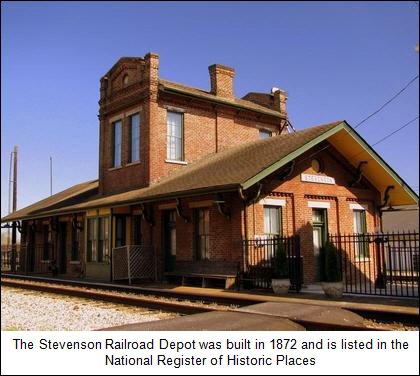

Back To News/PR Index
|


In the late 1880’s through the early 1900’s, Chattanooga, Tenn. was a major hub for both industrial and passenger railway service in the South. To relieve the over-crowding of Chattanooga’s rail system, construction of a new passenger terminal began in 1906 and the first train arrived at Chattanooga’s Terminal Station in 1909. The depot grew to serve nearly 50 passenger trains a day. Southern Railway vacated Terminal Station in the early 1970s, but was rescued by a group of local businessmen who were inspired by the theme of the "Chattanooga Choo Choo" song, made famous by the Glenn Miller Orchestra. They invested four million dollars and in 1973, Terminal Station was reopened to the public as the Chattanooga Choo Choo Hilton and Entertainment Complex. In 1989, another group investors invested another four million dollars in renovations to the complex. Today, the 24-acre complex boasts three hotel buildings, five restaurants, a variety of retail shops, an educational antique trolley ride, model railroad museum and display and more. Guests can even overnight in beautifully restored authentic sleeper cars. Another popular attraction in Chattanooga is the Tennessee Valley Railroad, a museum on wheels, taking visitors on a trip back in time. This is Tennessee’s only regularly scheduled, full-sized train ride and guests can choose from themed trips centered around holidays, dinner trips and day-trip excursions to scenic locations such as Hiwassee River Gorge, Summerville, Georgia and the former mining town of Copperhill. The historic L&N Depot Museum in Etowah, Tenn. is rich in history. In 1902, the L&N Railroad planned the first community on the direct route between Cincinnati to Atlanta at the base of the Cherokee National Forest. The town of Etowah emerged in 1906 and the first public building constructed was the L&N Depot. The two-story Victorian style, 16-room depot features unique woodwork including a decorative staircase leading to the upper floors. In 1977, the city of Etowah purchased the depot and restored the building before opening it to the public. Today, the L&N Depot houses a museum and serves as the boarding and ticket facility for the Hiwassee River Rail Adventures train excursions which carry passengers up the Hiwassee River, through the Cherokee National Forest, over the Historic L&N “Loop.” An
important Civil War railroad junction, the Stevenson
Railroad Depot Museum is situated between the tracks of two major railroads
in downtown Stevenson, Ala. The museum houses a collection of military,
agricultural, Indian artifacts, railroad, pioneer life and other local
memorabilia. The largest of these artifacts is the historic depot building
itself. Built in 1872, the depot stands on the ruins of Stevenson's first
railroad depot, which was built around 1852 for common use by the Nashville
and Chattanooga and the Memphis and Charleston Railroads. The original
depot was destroyed either during, or shortly after, the Civil War. Local
historians believe the bricks salvaged may have been used in the building
of the present structure.
 Just a short drive from Stevenson is the mountaintop town of Fort Payne, home of the Fort Payne Depot Museum. Built in 1892 at the height of Fort Payne's coal and iron mining boom, the unique Richardsonian Romanesque building served as a depot for the Alabama-Great Southern Railroad for approximately 85 years. A group of preservation-minded citizens acquired the building from Norfolk-Southern Railway in 1985, when the railroad announced plans to close it. Funds were raised locally for the restoration of the building. It opened as a museum in 1986. Today, the Fort Payne Depot Museum houses several permanent and rotating exhibits in two separate buildings. Both properties are listed on the National Register of Historic Places. Visitors can view local DeKalb County and Fort Payne history, extensive examples of Native American basketry, pottery, and artifacts, memorabilia from the Civil War, World War I and II, as well as the Vietnam War. The Depot Annex located in the Fort Payne Coal and Iron Building houses rotating exhibits. Another historical landmark worth visiting is the Dalton Freight Depot, which was originally built as the Southern Railway Freight Depot in 1911. Restored in 2009, the Depot includes exhibits from the Civil War and early Railroad eras. Visitors can enjoy the train-viewing platform where the main lines for both the CSX and Norfolk-Southern Railways pass and cross on a diamond pattern in front of the Depot. Dozens of trains pass by daily and the Depot's computerized ATSC system allows train enthusiasts to view trains as they approach downtown Dalton. Visitors can experience a true engineering marvel of its day as they walk through the first major railroad tunnel in the South at Tunnel Hill Heritage Center and Historic Railroad Tunnel located in northwestern Georgia. Built completely by hand by hundreds of Irish immigrants, it was finished in 1850 and became the final connection on the first railroad through the Appalachian Mountains reaching the Tennessee River. Visitors are treated to guided tours by trained staff. Along with a tour of the historic tunnel, visitors can spend time in the tunnel museum, which contains artifacts from the construction and renovation of the tunnel as well as Civil War and Native American exhibits. “A railroad-themed getaway in the Tennessee River Valley is easy to plan,” said Julie Graham, spokesperson for the Tennessee River Valley Mapguide Council. “A visit to Chattanooga and just a short drive to the north and to the south take train enthusiasts on a journey filled with memory-making activities including seeing important Civil War junctions, sleeping in an authentic railroad car and walking through a historic tunnel.” Along with these interesting rail museums and historic depots, the Tennessee River Valley offers a compelling story, captivating visitors with its little unknown facts, pristine, untouched areas and rich, authentic experiences. Plan a trip easily with the Tennessee River Valley Geotourism MapGuide, an online guide to explore authentic places and adventures that have been recommended by locals. Media
Contact:
|
